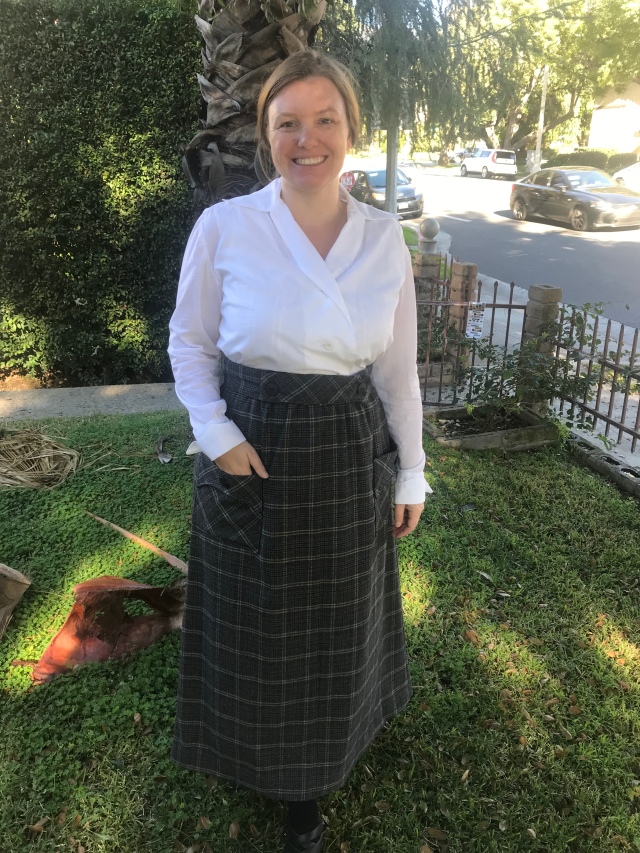One of my biggest projects of 2017 was tackling a mourning outfit. Every year Heritage Square holds an event that explores Victorian mourning customs including a mock funeral procession. I really needed something I could wear to the event each year, however I’m never actually in the mock funeral. I prefer a station in one of the other areas of the museum, especially since I bring my older daughter along. So as I was researching mourning wear I had a generous time frame to pull from (1870-1920). I also wasn’t restricted to the deep mourning of the recently deceased. It was freeing and yet felt pretty overwhelming.
Since I knew I’d be tackling this project for the fall I kept a look out for fabrics and hoped that eventually the right thing would come along and help narrow down my choices. Luckily I was able to get some black cotton lace yardage in a destash for a reasonable price. Shortly afterwards I found lavender cotton sateen (no longer available) at Renaissance Fabrics and the two paired together so nicely. A half mourning dress would be perfect for our annual event!


I spent a whole lot of time looking at pictures of extant gowns to see if anything had used black lace and lavender. I found…not many options. Information about mourning clothes seems to be a little harder to find in the Edwardian-1920s period. I probably could (and should) have done more research, but I needed to get sewing. So I found a pattern that was very similar to the gowns I liked from 1910-1912 and ran with my vision.

I think I did pretty well. The wrap front bodice with guimpe underneath is completely period appropriate. So was the lace overlay on the skirt and a belt (with bonus heirloom buckle from my MIL!). Not an exact match to my examples, but the basic elements are the same. The one detail that might have been nice to include is the contrast trim at the neckline, but I got a little fatigued during the process. The cotton sateen also turned out a little thicker than I remembered and so I started cutting elements to decrease the bulk.


For such a time consuming project I don’t really remember many of the details. October was kind of a whirlwind between making this dress and planning my younger daughter’s 3rd birthday party.
I decided not to line the dress because the sateen was pretty bulky. The front neck edge has a bias binding hand sewn on. The pattern (Butterick 6093) called for a side zipper and I swapped that for hook and eye. I thought about having the lace overlap in the front, but now I can’t remember why I decided against it. Maybe not enough lace fabric? Lazy? Too tired? Maybe all of the above. Butterick patterns fit me decently well so the fitting process was not too bad. I compared the shoulders to my recently completed Jennifer Lauren Laneway dress and otherwise blended sizes. I’m getting better and faster at mock ups so the process moves a little more quickly. I need to trust my gut instinct more frequently.
The guimpe was made with Wearing History’s Edwardian Era pattern. I bought it because it was one of the only patterns I could find for a guimpe and I didn’t have the brain power to figure it out for myself. I could have drafted my own and it probably would have fit better, but I was balancing too many things in my life.
Because nothing could go smoothly, the original fabric I ordered for the guimpe ended up sold out. The seller more than made up for the inconvenience, but I had hoped for something slightly more transparent. This is black wool gauze. One thing I totally didn’t see coming was how badly the gauze would combine with the underside of the sateen. The fabrics LOVE each other. So now every time I wear this ensemble I have to have my husband yank my under sleeves for me. Whoops! Thankfully once they’ve been pulled down everything fits nicely and stays put.

And then after wearing my new dress to the museum, it got a second life as my Halloween costume. For my daughter birthday I dressed as a witch and my adorable mom dressed as a gnome. Getting to wear the dress two days in a row was fun, and adding a witch hat was super simple. I purchased one from a halloween store and covered it with lace scraps from the dress. Whew! Thank goodness I didn’t need to make a mourning dress and a costume for the same weekend!
How’s everyone settling into 2018? I’m really trying to keep a positive attitude and in a couple weeks I’m going to follow along with the Orange Theory Fitness Transformation Challenge. I’m not officially signing up because I cannot physically make it to 3 classes a week, but will aim to work out 3 days a week and to OTF 1-2 a week. I’ve been attending classes for 6 month now and have made a ton of progress on my fitness. Plus the 8 week challenge sounds fun to way to kick a few bad habits.



















